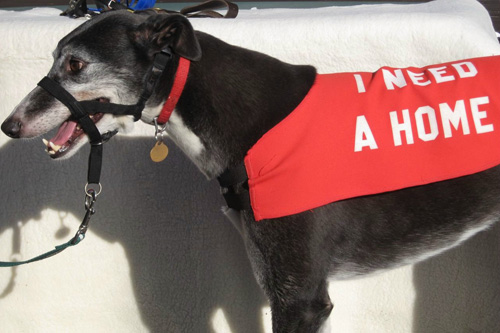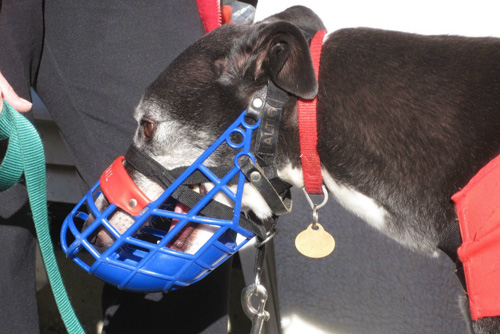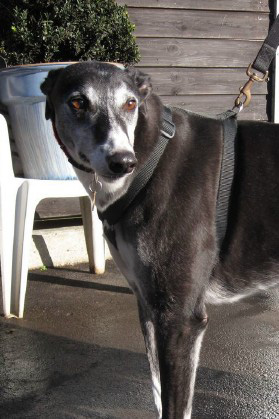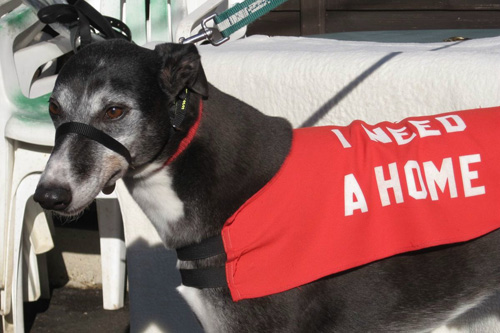Adopting the Special Needs Greyhound
Let us first state that each and every greyhound is special and that they all deserve a long, comfortable, safe and happy future with their own families to love and care for them.
This feature however is aimed at benefiting those extra special greyhounds still waiting for home offers. These extra special greyhounds are likely to have “special needs” in some form or possibly they just don’t seem to “stand out” when people come to visit with a view to adoption and they are overlooked time and time again.
Examples of these “special needs” greyhounds could be:
- The excessively timid or fearful greyhound
- The over-exuberant “Zeberdee” greyhound
- The exercise restricted greyhound
- The older greyhound
- The ‘keen’ greyhound
- The not-so-handsome greyhound
- The black greyhound
- The big greyhound
- The reticent greyhound
- The un-mannered greyhound
Any or all of the above could be the cause of a greyhound not finding the home it deserves quickly. In some cases a particularly special or experienced “doggy home” will be a requirement for that dog or bitch to ever be adopted.
The timid or fearful greyhound
A greyhound like this will often benefit from several visits from his/her potential adopters to allow it time to get to know them a little and begin to trust them in an environment it is familiar with. It can also be extremely beneficial to the nervous dog to have another calmly confident dog in the household already.
The “dog to dog” bond will help the new and nervous arrival feel more secure and quite often the fearful dog will attach itself to the calm one as though he/she were a “security blanket”.
People considering the adoption of a fearful greyhound will need at huge amount of patience and understanding of the dog’s fears and they should not expect the dog to show its affection for them for a long time.
Depending on the extent of the dog’s fear it might take several months for your gentle encouragement to pay off and for you to receive that first wonderful nuzzle or cuddle from your nervous dog. Once the nervous greyhound does trust you however and it will come to you happily, you will get the most amazing sense of achievement for yourself and you will feel incredibly proud of your dog.
Each “little step” on the route of confidence building also gives you a happy “goose bump” sort of feeling. Please also be aware that there will always be the possibility that something you do may trigger an episode of panic and you and your greyhound may find your relationship taking several steps backwards again.
The “Zeberdee” Greyhound
People can find being faced with a greyhound who just does not seem to stop leaping and jumping at them extremely off-putting. Quite rightly so as on some occasions being jumped at can be painful or even cause injury if the dog unintentionally scratches, bruises or sends you falling to the ground.
Please bear in mind though that a dog in kennels is often incredibly pleased to see people. His/her leaping around is commonly just a case of pure uncontrollable excitement at the prospect of some “people time” and a bit of fun. Whilst a kennel environment does provide time and attention to each dog, it cannot do so to the same extent that a dog would enjoy if it were in a home, with daily remedial training and a family of it’s very own.
Try to see past the initial exuberance, give the dog sufficient time to settle down calmly and then get to know the dog. Never reward jumping up, it only encourages the action. Even persistent jumpers can be re-trained. Often just turning your back every time they jump up is sufficient to cure the problem. In other cases reward based training may help or the services of a dog trainer.
If the only thing stopping you from adopting a “Zeberdee” dog is it’s bounciness, do remember that it can be cured. Having said that a “Zeberdee” dog with young children is not necessarily a good idea, there might be too high a risk of the child being hurt or the child developing a lifetime fear of dogs from his/her experience.
Perhaps in this case a calmer greyhound would be the better choice.
The Exercise Restricted Greyhound
Occasionally there are greyhounds who for life will require limited or restricted forms of exercise. If you enjoy an active lifestyle then the injured or exercise restricted greyhound is probably not suited to you. If you are perhaps retired or just not into long hikes and are seeking a faithful companion animal then this greyhound may be the ideal companion for you.
Regardless of injury, greyhounds are loyal and gentle companions and they will adore just having someone of their one to keep company with.
The Older Greyhound
The older greyhound is not usually a difficult dog to find a home for from a behaviour or temperament point of view, but sometimes placing an older greyhound in a home can prove extremely difficult. Obviously people consider the length of time they may have with the dog, and the older greyhound obviously will have less time than a much younger dog.
However, the older dog is a deserving case, they want only decent meals, a little exercise and a lovely soft bed, some warmth and companionship so they can contentedly snooze most of the day away. The older greyhound may suffer from age related problems, perhaps his eyesight or hearing isn’t as good as it was, perhaps he suffers from arthritis or just aches and pains, but many of these problems can be alleviated effectively and quite cheaply.
Older greyhounds can make the most gentle of pets and they are often an ideal companion for people who just enjoy a gentle stroll around the park. They can also be great pets in family homes, making fewer demands on you than a younger one who may want more exercise and frequent playtimes.
If you have children however, the children must understand that an older greyhound will simply want to sleep for much of the day and not play ball or chase with them too often.
The “keen” greyhound
Greyhounds are members of the sight hound family, their instinct is if it moves, chase it. Most can be successfully re-trained so that smaller dogs or even cats do not trigger their chase instinct. Some however, will prove difficult in this respect and they may well need a very special family who are familiar with the chase instinct and who take every precaution to ensure no unfortunate incidents occur.
We strongly recommend using a greyhound muzzle for all outings with newly adopted greyhounds anyway, at least until you are 100% sure your greyhounds reaction to other breeds of dog is always friendly. For the particularly “keen” greyhound, people prepared to utilise a greyhound muzzle long term are essential. Additional forms of control are also recommended in some cases. Just because your new greyhound is keen, it does not mean you cannot enjoy the other aspects of his/her character to the full.
If you do adopt a “keen” greyhound seek help or advice from your rescue or homing organisation, consider socialisation or even one to one training and use every opportunity offered to get your greyhound familiar with other breeds. If necessary explain the situation to people you meet, ask for their help with socialising your dog and assure them that your dog is under control and muzzled so he/she really is totally harmless even if he/she appears to be aggressive.
Meeting feisty little dogs is often of great benefit to your greyhound and sometimes it helps them to realise that it doesn’t matter how large or small another dog is, it might have “attitude” too, a voice and it is therefore a dog requiring respect.
The not so pretty/handsome greyhound
Sometimes much like people, greyhounds are not always blessed with instant “wow” appeal. The not so handsome or pretty greyhound is often overlooked. OK, he or she may not be a beauty contest winner, but they, like all greyhounds have character and affection in abundance if people take the time to find it.
Please consider the not so attractive greyhound along with those with instant “wow” appeal. They have loving hearts too and just need the opportunity for their beautiful characters to shine through and snare you forever.
The black greyhounds
Unfortunately statistics prove that black greyhounds are the hardest to home. Why? A black greyhound in superb condition is absolutely stunning. A black greyhound in need of some T.L.C. is unfortunately not so stunning and they can look far worse than other colours.
Having a black coat means that curable problems like dandruff, bald patches or simply a winter coat can be off-putting, everything seems to show more on a black coat. Give a black greyhound a chance and a few months of grooming, possibly cod liver or evening primrose oil (to improve dandruff and general coat condition) and before long you will have a gleaming, shiny stunner.
Black greyhounds seem to predominate the greyhound world and unfortunately some people associate black dogs (like cats) with evil, others find them too common and want something a little more unusual. There are many varied reasons why a black greyhound can be overlooked for adoption.
Please give the black boys and girls a chance and judge them more on character than coat colour. None of us had any say in the colour of hair we were born with, nor do greyhounds.
The big greyhound
Sadly a lot of people only want a small greyhound, they feel that a big one will take up too much room or perhaps be too strong for them. Well, if your space truly is that limited then maybe a smaller greyhound is essential in your circumstances, but many people would be surprised at how small even a big greyhound can become when it curls into a sleepy ball.
The big guys/girls can indeed have a problem finding a home, but there are a few homes out there that only want a big greyhound. We have known particularly tall people want a tall dog (they feel they would look silly with a little one), we know people that have always had large or giant breed dogs before and truly adore the big ‘uns.
Again, we suggest you do not pre-judge any greyhound. Take the time to meet them and make a decision based on not just the size of the dog or bitch, but on the overall “greyhound appeal” that dog gives you.
The reticent greyhound
Often an individual greyhound fails to “sell itself” to people. It might be reserved, aloof or careful about showing affection to people. These types of greyhound are often the ones that show outstanding loyalty to those people who have taken the time to know them.
Even in homing kennels there are greyhounds that initially “do nothing” for the helpers, but given a few more meetings and a chance for the dog to show it’s real character, those dogs frequently become the favourites.
For the reserved or non-demonstrative greyhound it often pays off to pay a few visits to him/her and truly get to know the dog before making a decision. Very often a greyhound will pick it’s own home and sometimes an aloof greyhound will transform into a “cuddle bunny” when he/she decides the right family has finally arrived to adopt him/her.
The “unmannered” greyhound
On occasion you may find a greyhound who has failed to learn any walking manners whatsoever. This is rare, but it does happen. These greyhounds too, often find it hard to find a home. A strong greyhound is by no means impossible to manage if you have the right aids to help you and the determination to succeed.
Our Greyhound Collars page would be useful reading for this type of dog. Perhaps this type of greyhound is not suitable for the older folks or the children to walk and if the dog really is too strong for you to manage safely then look for one less determined to take you off your feet.
By using aids like a Canny Collar or Halti in addition to a standard greyhound collar and lead even the strongest of dogs can be handled with minimal physical effort until you have succeeded in teaching them some basic manners. Perhaps you could train him/her yourself, perhaps you would benefit from the assistance of a dog trainer.
In all cases regardless of the dog’s age, they can all learn to walk along politely. Once achieved, you and your greyhound can then both enjoy your walks out without worrying about sore, aching muscles or a stiff and bruised neck. Patience and consistency really pays dividends with the unmannered greyhound.
Summary
We hope this feature has helped to “open your eyes” to those greyhounds who do not necessarily have the instant appeal of some of their companions and that perhaps if your circumstances are right you might give consideration to adopting one of the harder to home greyhounds.
If you have any questions please leave a comment, thanks.
Greyhound Frequently Asked Questions »











